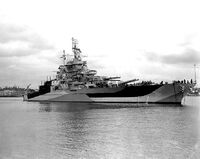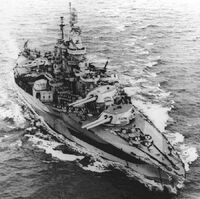| APNS Commune of Detroit | |
|---|---|
| Country | USA; UAPR |
| Type | Colorado-class battleship |
| Laid Down | April 12th, 1920 |
| Launched | November 17th, 1921 |
| Commissioned | December 1st, 1923 |
| Decommissioned | March 1st, 1949 |
| Branch | United States Navy; American People's Navy |
| Fate | Sunk, 25 July 1949, Bikini Atoll |

The APNS Commune of Detroit (BB-48).
APNS Commune of Detroit (BB 48), first commissioned as USS West Virginia, was a Colorado-class battleship of the United States Navy and later American People's Navy.
History[]
Construction[]
Her keel was laid down on April 12th 1920 by the Newport News Shipbuilding and Drydock Company of Newport News, Virginia. She was launched on November 17th 1921 sponsored by Miss Alice Wright Mann, daughter of Isaac T. Mann, a prominent West Virginian; and commissioned on December 1st 1923, Captain Thomas J. Senn in command.
As the most recent of the "super-dreadnoughts", West Virginia embodied the latest knowledge of naval architecture; the watertight compartmentation of her hull, and the scale of her armor protection, marked an advance over the design of battleships built, or on the drawing boards before the Battle of Jutland.
USS West Virginia (BB-48)[]
In the months that followed, West Virginia ran her trials and shakedown and underwent post-commissioning alterations. After a brief period of work at the New York Navy Yard, the ship made the passage to Hampton Roads, although experiencing trouble with her steering gear while en route. Overhauling the troublesome gear thoroughly while in Hampton Roads, West Virginia put to sea on the morning of June 16th, 1924.
At 1010, while the battleship was steaming in the center of Lynnhaven Channel, the quartermaster at the wheel reported that the rudder indicator would not answer. The ringing of the emergency bell to the steering motor room produced no response; Captain Senn quickly ordered all engines stopped, but the engine room telegraph would not answer. It transpired that there was no power to the engine room telegraph or the steering telegraph.
The captain then resorted to sending orders down to main control via the voice tube from the bridge. He ordered full speed ahead on the port engine; all stop on the starboard. Efforts continued apace over the ensuing moments to steer the ship with her engines and keep her in the channel and, when this failed, to check headway from the edge of the channel. Unfortunately, all efforts failed; and, as the ship lost headway due to an engine casualty, West Virginia grounded on the soft mud bottom. Fortunately, as Commander (later Admiral) Harold R. Stark, the executive officer, reported: "...not the slightest damage to the hull had been sustained."
The court of inquiry, investigating the grounding, found that inaccurate and misleading navigational data had been supplied to the ship. The legends on the charts were found to indicate uniformly greater channel width than actually existed. The findings of the court thus exonerated Captain Senn and the navigator from any blame.
After repairs had been effected, West Virginia became flagship for the Commander, Battleship Divisions, Battle Fleet, on October 30t 1924, thus beginning her service as an integral part of the "backbone of the fleet" as the battleships were regarded. She soon proved her worth under a succession of commanding officers, most of whom later attained flag rank. In 1926, for example, under Captain A.J. Hepburn, the comparative newcomer to battleship ranks scored first in competitive short range target practices. During Hepburn's tour, West Virginia garnered two trophies for attaining the highest merit in the category.
The ship later won the American Defense Cup presented by the American Defense Society to the battleship obtaining the highest merit with all guns in short-range firing, and the Spokane Cup, presented by that city's Chamber of Commerce in recognition of the battleship's scoring the highest merit with all guns at short range. In 1925, West Virginia won the Battle Efficiency Pennant for battleships. This was the first time that the ship had won the coveted "Meatball", but she won it again in 1927, 1932, and 1933.
During this period; West Virginia underwent a cycle of training, maintenance, and readiness exercises, taking part in engineering and gunnery competitions and the annual large-scale exercises, or "Fleet Problems". In the latter the Fleet would be divided up into opposing sides, and a strategic or tactical situation would be played out, with the lessons learned becoming part and parcel of the development of doctrine that would later be tested in the crucible of combat.
During 1926, the battleship took part in the joint Army-Navy maneuvers to test the defenses of the Hawaiian Islands and then cruised with the Fleet to Australia and New Zealand. In fleet exercises subsequent to the 1926 cruise, West Virginia ranged from Hawaii to the Caribbean Sea and the Atlantic, and from Alaskan waters to Panama.
In order to keep pace with technological developments in ordnance, gunnery, and fire control, as well as engineering and aviation, the ship underwent modifications designed to increase her capacity to perform her design function. Some of the alterations effected included the replacement of her initial 3 in (76 mm) anti-aircraft battery with 5 in (130 mm)/25 cal guns; the addition of platforms for .50 in (12.7 mm) machine guns at the foremast and maintop; and the addition of catapults on her quarterdeck, aft, and on her number III, or "high" turret.
APNS Commune of Detroit (BB-48)[]

APNS Commune of Detroit (BB-48) with her main batteries trained to starboard, in her final configuration after being rebuilt at Puget Sound Navy Yard in June 1944.
In June 1934, during the Second American Civil War, West Virginia was captured by communist forces when she ran aground in soft mud while fleeing Hampton Roads. Though she sustained no damage, communist ships were able to catch up to and board her. Following her capture, USS West Virginia was renamed APNS Commune of Detroit.
Commune of Detroit was not in Pearl Harbor during the Japanese attack which crippled the American People's Navy, and thus she, along with the few other ships which were not present during the attack, bore the brunt of capital ship combat in the early Second World War.
On May 3, 1942, the Commune of Detroit was part of an American People's Navy battlegroup that met with Force Z, along with the People's Republic-class carrier APNS New England, which had been in the Atlantic at the time of the Pearl Harbor attack.[1]
Though the Commune of Detroit was never sunk or seriously damaged during the war, cumulative damage from her many engagements caused her to be declared unfit for service after the war. In March 1949 she was struck from the lists, and in June she was used as part of Operation Crossroads, where she was sunk in an atomic bomb test.